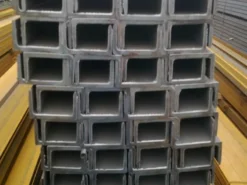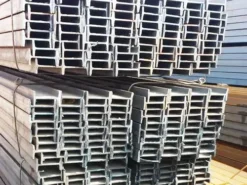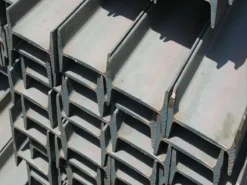Channel steel is a long strip of steel with a groove-shaped cross-section. It is a carbon structural steel used in construction and machinery. It is a profile steel with a complex cross-section and has a groove-shaped cross-section. Channel steel is mainly used in building structures, curtain wall engineering, mechanical equipment and vehicle manufacturing.
-Basic Situation:
In use, it is required to have good welding, riveting performance and comprehensive mechanical properties. The raw material billets for producing channel steel are carbon steel or low alloy steel billets with a carbon content of no more than 0.25%. The finished channel steel is delivered in a hot-formed, normalized or hot-rolled state. The specifications are expressed in millimeters of waist height (h) * leg width (b) * waist thickness (d). For example, 100*48*5.3 means that the waist height is 100 mm, the leg width is 48 mm, and the waist thickness is 5.3 mm. Steel, or 10# channel steel. For channel steel with the same waist height, if there are several different leg widths and waist thicknesses, it is necessary to add a b c to the right of the model number to distinguish them, such as 25#a 25#b 25#c, etc.
-Classification:
Channel steel is divided into ordinary channel steel and light channel steel. The specifications of hot-rolled ordinary channel steel are 5-40#. The specifications of hot-rolled modified channel steel supplied by agreement between the supplier and the buyer are 6.5-30#. Channel steel is mainly used in building structures, vehicle manufacturing, other industrial structures and fixed panels. Channel steel is often used in conjunction with I-beams.
Channel steel can be divided into 4 types according to shape: cold-formed equal-edge channel steel, cold-formed unequal-edge channel steel, cold-formed inner curled channel steel, and cold-formed outer curled channel steel.
According to the theory of steel structure, the channel steel wing plate should bear the force, that is to say, the channel steel should be standing up instead of lying down.
-Theoretical Weight:
5#: 50*37*4.5=5.438kg/m
6.3#: 63*40*4.8=6.634kg/m
6.5#: 65*40*4.3=6.709kg/m
8#: 80*43*5.0=8.045kg/m
10#: 100*48*5.3=10.007kg/m
12#: 120*53*5.5=12.059kg/m
-Specifications:
The specifications of channel steel are mainly expressed by height (h), leg width (b), waist thickness (d) and other dimensions. The specifications of domestic channel steel range from 5 to 40, that is, the corresponding height is 5 to 40cm.
At the same height, light channel steel has narrower legs, thinner waist and lighter weight than ordinary channel steel. No. 18 to 40 are large channel steels, and No. 5 to 16 are medium channel steels. Imported channel steel is marked with actual specifications, dimensions and related standards. The import and export orders of channel steel are generally based on the specifications required for use after determining the corresponding carbon steel (or low alloy steel) steel grade. Apart from specification numbers, steel channels do not have a specific composition and performance series.
The end length of channel steel is divided into two types: minute ruler and double ruler, and the allowable difference is stipulated in the corresponding standards. The length selection range of domestic channel steel is divided into 5-12m, 5-19m and 6-19m transparency according to different specifications. The length selection range of imported channel steel is generally 6-15m.











